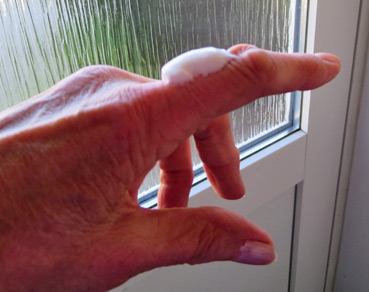I will here explain what I do and about
a lille smart trick when I brush my dog's teeth every morning.
I hope this will help others...
My personal experience
After several years with Whippets and no dental problems, (where I only kept an eye), I acquired a Whippet who was
1 1/2 years old, and already at this young age, he had developed lots of tartar. He had to have his teeth cleaned at the vet and I was shocked at how expensive it was! Therefore, having learnt the hard way, I started brushing the teeth of all my dogs every single day. It is very important to form a set habit that you never break. Brushing just once in a while is not enough and the task is easily postponed, forgotten or you get too busy. A good, fixed habit is best for you and the dogs and it must be done daily, otherwise tartar will develop anyway.
I
decided the ritual would happen every morning before they had their breakfast. I have them “trapped” in the small utility room after a run in the garden and the dogs are very focused on the fact that they will soon get breakfast and are extra hungry in the morning. It has been a long time since their last meal. This, and the fact that dogs can only think about one thing at a time, helps a lot when you have to do something that they don't really care for!
1) But before this, start by taking a good look at your dog's teeth
If they are "bad", could it be that they need to be cleaned by the vet first? No matter how diligently you brush, you cannot clean already “well-limed up" teeth back to health. Tartar that HAS formed cannot be removed by brushing alone. Brushing's primary job is to keep tartar from ever forming! Therefore it MAY be that you have to bite the bullet and pay for a dental cleaning at the vet - after which you can maintain the teeth health for the rest of the dog's life. Therefore, look carefully at it's entire set of teeth with your reading glasses on first! I have also learned that in some dogs, a little tartar CAN form even when you brush well. But all dental care helps - and postpones the expensive operation. So if you have the slightest doubt, ask your vet for advice.
2) Buy a tube of dog toothpaste with a good flavour, like poultry/chicken, or liver pâté etc.
There are several types, so see what your dog likes best. Mine love the "poultry" one!
3) The toothbrush I use is "medium".
(Remember that they need to be replaced after about a month, just like ours.) A cheap brand of "human toothbrushes" is just fine for my Whippets and Italian Greyhounds. There are also toothbrushes specially designed for dogs, but I have never tried any.
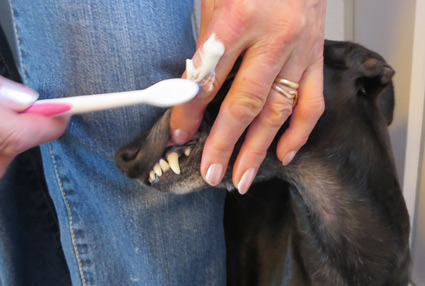
4) My little trick:
With the toothpaste and toothbrush ready in each hand, the first problem presents itself:
You have THREE things to hold including the dog's snout, but only two hands? In the right hand you have the toothbrush ready to brush with - and so you only have the left hand to both hold the muzzle, open the dog's mouth, press the corner of the lips back AND at the same time squeeze something out of the toothpaste tube several times and get it on the brush! Meanwhile, the dog has escaped!
This is an impossible task! You should also not stick the toothbrush in the dog’s mouth with one huge dollop of toothpaste, which then foams up, drips everywhere and is swallowed in copious amounts!
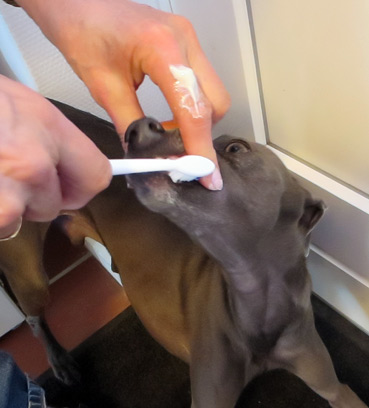 .
.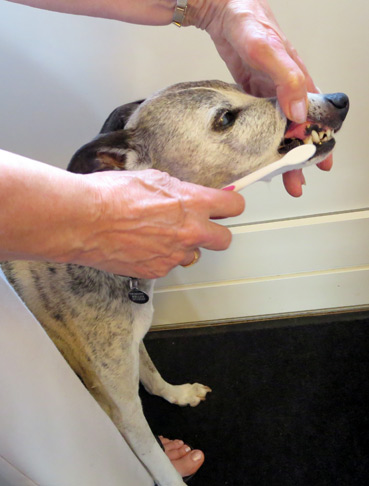
So I invented mashing the "little sausage" of toothpaste off the brush and onto the top of my left index finger.
See all the photos.
I then hold the toothbrush in my right hand and brush carefully, while my left hand can easily grip the dog's muzzle, push the corners of its lips back, (one side at a time) and I can often “dip” the toothbrush in the toothpaste sausage sitting on my finger, just like an artist dabs a paintbrush into a color on his palette! Thus I "work" my way 190 degrees around the muzzle and carefully brush all the teeth. This saves the difficulty of constantly having to let go of the dog in order to squeeze more toothpaste out of the tube.
Beforehand, I enclose the dogs in a very small room with good light - in our case it is the utility room - and I back the dog into a corner. (They quickly learn to stand there by themselves.) The whole procedure only takes less than a minute in all and as a reward afterwards, the dog is allowed to lick my finger clean. They take great pride in licking every single molecule away!
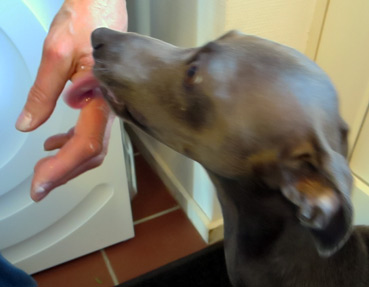
5) But first, the dog needs to get used to this!
I teach the dogs to "endure" this ritual from day one by having the dog sniff the brush and the toothpaste and then I lightly touch the nearest canine tooth with the toothbrush for a second at the beginning. Then day by day and week by week, I take a little more grip and slowly expand to cleaning the entire set of teeth - but still only a very lightly and superficially, NEVER so much that the dog shows discomfort of any kind. It must be willing to join in "Mum's silly ritual". All mine surrender because partly they like the taste and partly (and not least), because they can see that the sooner it's over with, the sooner they get their breakfast that is waiting!
If you have an easy-going, older and calm dog that allows you to do anything, you can let a puppy (or your other dogs) see "how well" the old one is taking it. They often become eager to have their turn when an adult dog shows the way! That's how I've taught each of my "new" dogs, who simply don't know a life without this short toothbrushing job every morning - and that's how my lively "impossible" Italians have seen my quiet and patient whippets, so they could hardly wait until it was their turn. (I had one who went bonkers with anticipation, so he got a stuffed animal to shake while he waited his turn – and this worked fine!) In the end, the dogs allow everything and I'm lightning fast.
The set habit turns into just something "their crazy mother insists on doing!"
Tip: I know that the most logical thing is to brush teeth after eating, possibly in the evening, as we humans do - but it is better for the dog and its willingness to cooperate if it happens just BEFORE a meal, because it quickly realizes that the faster it’s teeth are done, the faster it gets its food!
Tip: Dogs will automatically back away, so helped by the fact that it is stuck in a corner of the very small room, you can also put a leg behind it, so you actually have quite good control and can keep it more easily "fixed" - without forcing of any kind, but it feels that you have it under some control! I can't emphasize enough how important it is to go slow and do a little bit every day long before you finally brush "properly".
6) If you have a puppy,
one has a year or more to lteach it this ritual. Puppy and young dog teeth stay clean for at least a year or more. You only need to play "Mom brushes your teeth" for the first year, so that it quickly becomes pure routine for both of you and you can see how it tolerates more and more - long before it is a necessity - if at all. As I said, it is impossible to know in advance whether the puppy is one of the lucky ones who mysteriously always has nice teeth, or whether it easily forms tartar and may still end up at the vet for a dental cleaning under anesthesia, despite all one's efforts. Therefore, take no chances and play the "clean your teeth" game on your puppy from the start - and always at the same time. It is important for YOU to get into a good habit that you never break or become careless with.
A puppy has plenty of time to build up trust in you while you “mess around” more and more in its mouth. I have achieved so much trust that I can do everything with my dog's lips/teeth, I can take a good grip and really scrub and sometimes I have to hold the jaw quite hard. I'm very quick about it though.
NB If you are going to show your dog
then it must be totally relaxed about being looked at in the mouth by various foreign judges.
Therefore, the dog must not in any way think teeth cleaning is unpleasant, but slowly get used to you pulling on its lips and staring into its mouth with a light touch with the brush!
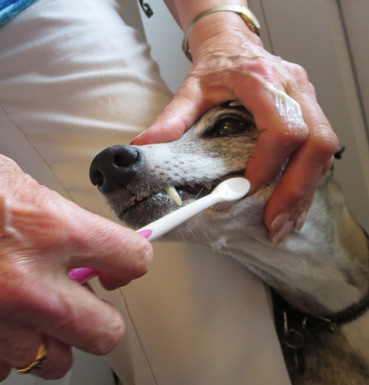
Even "impossible" dogs and small, lively dogs, like my two Italians, CAN get used to brushing their teeth if you teach them slowly over time - and brush just before a meal. With my simple trick of putting the toothpaste on your finger and dabbing into it as you go, you're lightning fast, it's dead easy, and you don't need three hands!
So let us put the vet's teeth-cleaning aparatus out of work and save both our dogs and our purses for pains!!!!Janet Frimodt-Møller
The photos are of my two Italian Greyhounds and a friend's Whippet that I often look after.
